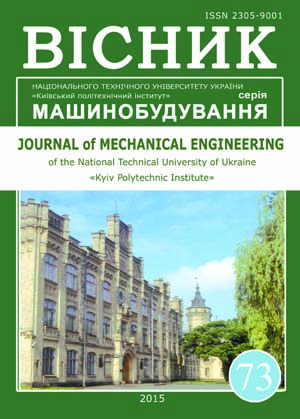THE EFFECT OF TOOL WEAR ON CUTTING TEMPERATURE WHEN DRILLING CFRP/STEEL STACKS
DOI:
https://doi.org/10.20535/2305-9001.2015.73.40943Keywords:
composite, tool geometry, force, carbide tool, temperature measurementAbstract
This paper presents tool wear study based on the drilling experiment of CFRP/ steel stack. The most common problems of CFRP/metal stacks machining are CFRP delamination, fiber pull – out, thermal degradation and intensive tool wear. Last decade such parameters of CFRP/metal stacks drilling as axial force and torque are in the focus of researches. However, the cutting temperature in the drilling process of CFRP/metal stack and its influence on drill bit wear is still not fully gained at the present time. The purpose of current study is to investigate the effect of cutting temperature on the tool life of carbide drill. The temperature was measured with K type thermocouple which was embedded on the flank surface of the drill. Axial force was measured with dynamometer. Data of cutting temperature and axial force was digitalized with analog – digital converter (ACD) and visualized on personal computer (PC). The dominating tool wear mode when drilling CFRP/steel - was flank wear which was measured with optical microscope. The experimental study of cutting temperature effect on the tool wear of carbide drill was established. It was found that the most unfavorable combination of stack materials in the conditions of drill wear is CFRP/metal.References
1. Jennise T. T.“Gravity Effects of Curing Angle on Laminated Composite Structures: A Review on Novel Study. Advances in Materials Science and Engineering. 2013 (2013): 1 – 10.
2. Boldt J. A. “Solid-tool machining and drilling ”. Engineered Materials Handbook. 1 (1987): 667 – 672.
3. Park K. H. “Tool wear in drilling of composite/titanium stacks using carbide and polycrystalline diamond tools” Wear. 271 (2011): 2826 – 2835.
4. Sheikh-Ahmad J. Y. “Machining of Polymer Composites.” Springer, New York, Chapt. 4 (2008): 122 – 131.
5. Faraz A. “Cutting edge rounding : An innovative tool wear criterion in drilling CCFRP composite laminate.” International Journal of Machine Tools & Manufacture. 49(2009): 1185 – 1196.
6. Prabhu P., “Machinability Study of Hybrid Nanoclay-Glass Fibre Reinforced Polyester Composites.” International Journal of Polymer Science. 2013(2013): 1-11.
7. Reimann W. “Bearbeitung von faserverstarkten Kunststoffen bei hohen schnittgeschwindigkeiten.” Technische Mitteilungen. 81 (1988): 240 – 243.
8. Zitoune R. “Study of drilling of composite material and aluminium stack.” Composite Structures. 92 (2010): 1246 – 1255.
9. Kumar M. “Study on Tool Wear and Chip Formation during Drilling Carbon Fiber Reinforced Polymer (CFRP). Titanium Alloy (Ti6Al4V) Stacks.” Procedia Engineering. 64 (2013): 582 – 592.
10. Panda A. “Analysis of Cutting Tools Durability Compared with Standard ISO 3685, 2012.” International Journal of Computer Theory and Engineering. 4(2012): 621 – 624.

